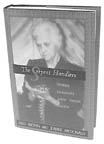|
Let's face it; if you're not a fan of Groucho and his kin, there is no reason to get this book. But if you recognize Groucho as the foremost comedian of the 20th century, the most brilliant man ever to put shoe polish on his upper lip and call it a mustache, then The Essential Groucho is a must. Edited by Groucho biographer Stefan Kanfer, The Essential Groucho is a collection of Groucho's best work throughout his career. Included are the best routines from the best Marx Bros. films- like the "Why a Duck?" sketch, Captain Spaulding's introduction, and more. Even a scene from the little known I'll Say She Is, the Marx Bros.' first stage success, has been found, as well as some bits from Flywheel, Shyster, and Flywheel, Groucho's first short-lived radio show. Also included are the highlights of his letters, such as to Warner Bros. when they contested the Marxs' use of Casablanca, and a few to Groucho's pen pal T.S. Eliot. Perhaps most exciting is a collection of Groucho's best ad-libs from the You Bet Your Life game show, both radio and television (even a few that had to be censored for content). There's no real insight into Groucho or his work to be found here, except that gleaned from an examination of his comedy career, but for the diehard fan or anyone who needs an unquestionable, guaranteed source of comedy, it is, well, essential. -Rob Bricken
 The GI Generation: A Memoir The GI Generation: A Memoir by Frank F. Mathias The University Press of Kentucky A memoir of the simple life, Frank Mathias' The GI Generation is about growing up happy in Depression-era Carlisle, Kentucky. Titled The GI Generation because he and his friends were destined for war but were oblivious to it growing up, Mathias writes stories about the people, events and places of his childhood that read like campfire tales. The book is about simple pleasures, and he attempts to capture what made the simplicity so wonderful. Throughout the narrative, he reminds us that almost all his playmates were World War II-bound, and their fates are included as afterthoughts to many of his stories. These afterthoughts simply disturb the rhythm of the book and belittle the lives of his old pals. It's a poorly executed attempt to find meaning in the short lives of the men he knew, and it distracts from the real subject of the book: his youth. While Mathias's intentions may be noble, the book ends up being a nostalgia trip, devoid of meaning for the reader. His determination to drive home the beauty of the era becomes repetitious. Too many times we read that no one had much money, but people were still happy. He seems obsessed with safety: life was safe, his town was safe, travel was safe. And the book is safe-too safe. Written in a weak prose style that relies too heavily on exclamation points, few of his stories are able to command the attention that he is seeking for small-town America. -Rick Johnson
The Serpent Handlers is an in-depth account of a religion (located mostly in the Appalachian regions) whose members feel called by God to handle poisonous snakes, drink poison, and speak in tongues during regular church service. By focusing on three different families in three different towns (in Tennessee, West Virginia, and Kentucky) the book puts a face-both socioeconomic and human-on this often-misunderstood religion. The narrative also shows how this practice has evolved and flourished in this particular area and with these particular people. The authors describe all aspects of this environment, reporting from the kitchens, churches and even funerals of some of the participants. Descriptions of religious services are vivid and gripping; you feel the heat in the room and hear the rattlers behind the altar. When exploring the families, the authors let them speak for themselves in long monologues. This approach allows the reader to meet these philosophies and lifestyles head-on and make interpretations and judgments on their own. The point is never to question the validity of these practices but simply to present the facts with clarity. However, the exhaustive depth and breadth of the book can also be a weakness. It explores the same thing three different times, but not necessarily from three different angles. Each family has their share of incredible stories, but a synthesis could have tightened the impact. In the end, the book is less about this small religion and its non-mainstream approaches to worship and more about normal people who struggle to follow a controversial calling. -Craig Beaven
|
 The Essential Groucho
The Essential Groucho  The Serpent Handlers: Three Families and Their Faith
The Serpent Handlers: Three Families and Their Faith